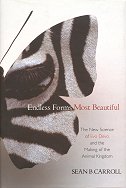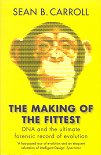This is an excellent account of the "new science" of evolutionary development (EvoDevo), explaining how animals have the forms and structures that they do, as a consequence of genetics, the developmental process from embryo to adult, and how all this has evolved. It provides a foundational plank of evolutionary theory. (The title is a quotation from the final sentence of Darwin's The Origin of Species.) The previous 1940s so-called "Modern Synthesis" of evolutionary theory misses out this key step of development: how a single cell grows, divides, differentiates and structures into an adult organism. Understanding this development also gives key insights into how evolution works.
In 300 clearly-argued and beautifully written pages, Carroll covers four areas:
The first thing to understand is that the typical "Ladybird book" model of genetics -- one gene codes for one protein, and proteins build the organism -- is severely lacking. It misses out the key fact of gene regulation:
That is, there is about twice as much regulatory DNA as coding DNA. Genes can be selectively switched on or off in different parts of the organism, and the regulation structure is a complex dynamic network itself mediated by genes and proteins. Many of the proteins expressed act in this network to control the expression of other proteins, rather than directly form building blocks of the organism's body.
Carroll doesn't say much about timescales, but it is clear from this passage that they must be important. Information is flowing through the system, (diffusion, oscillatory dynamics, etc), which is simultaneously growing. Not only changing these switches, but changing timescales (eg oscillation frequencies, growth rates) so that the information arrives sooner or later, would seem to be important.
One key point is that the same gene, expressed in different places, can have multiple different consequences. The Distal-less gene affects the growth of distal structures (legs and wings), but when expressed within a butterfly wing, also controls the formation of "eyespots" there. This trick is seen again and again: there are a few "tool kit" genes that do their stuff, but the details of what they actually do depends on where they are expressed, and that expression is affected by the regulatory network. (One thing that I don't think is made completely clear is how the genes know where they are in the embryo or developing animal: it appears from some of the discussion as if they might have some "absolute" location information, rather like latitude and longitude, but it isn't clear where that information comes from.)
Amazingly, the tool kit genes have been preserved virtually unchanged over many million years of evolutionary history (creatures as diverse as arthropods and vertebrates have many homologous tool kit genes): what has evolved is mainly the switching network. The motto is: keep the parts constant, evolve the processes by which they are combined.
Animals have a second trick: they use repetition (segmentation) to build multiple uniform structures (segments), then use different switchings to specialise individual segments in a different way.
This segmentation and specialisation allows evolution to work on parts of the body at a time: for example, various distal structures like mandibles, legs, wings, spinnerets, whatever, can evolve somewhat independently of each other. (In fact, the discussions of the amazing variety of body parts that "legs" have evolved into in different creatures is, well ... amazing!)
Thus the EvoDevo insight get round the "hopeful monster" problem of evolution: how a mutation can produce a different and more successful organism. That is, evolve control rather than components, in a modular structure. It also provides further ammunition (should it be needed) against anti-evolutionists. No-one (surely?) can deny that development occurs: the growth of a complete and complex organism from a single cell over a lifetime -- which lends credence to the evolution of complexity over the much longer evolutionary timescales.
And this link between evolution and development -- that evolution can proceed by exploiting developmental processes -- provides further understanding of how evolution actually works to produce novel complex structures. Evolution is a tinkerer that plays around with the tool kit it has got. A great example is duck feet. In the embryo, hands and feet are initially disc-like, and there is a gene that makes the skin between fingers and toes die off. In a duck's webbed feet, this gene is inhibited. In other words, the skin doesn't die away because the command that tells it to die away is stopped from occurring. Evolution doesn't remove the unnecessary gene (in the way that an intelligent programmer might remove unused code), it just blocks its expression.
There is a welcome cautionary note, hidden in the bibliography, against over-interpretation of overly-simplistic models. Just because a computational model replicates patterns seen in reality doesn't mean it employs the same mechanism as reality:
There is much more than this brief summary can encompass. This is an excellent book, and should be read by everyone with an interest in evolution.


